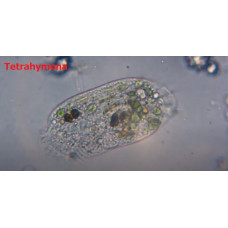Ciliophora is a type of the subkingdom Protozoa. Size from 12 microns to 3 mm. The shape of the body is diverse. Marine and freshwater protozoa. Move with the help of cilia. Unlike other Ciliophora protozoa, the nuclear apparatus has two nuclei: micronucleus and macronucleus. About 7,500 species. Some Ciliophora are parasitic forms.
There are mobile and attached forms, solitary and colonial. The body shape of infusoria can be varied, the size of single forms from 10 microns to 4.5 mm. They live in the sea and fresh water bodies as part of the benthos and plankton, some species - in interstitial, soil and mosses. Many of Ciliophora are commensals, symbionts and parasites of animals: ringworms, mollusks, fish, amphibians, mammals.
Some Ciliophora, e.g. Tetrahymena, Oxytricha trifallax are model organisms of molecular biology. The name "infusoria" is derived from Latin infusum ("infusion") from the place of initial detection of protozoa - in herbal infusions.
Probably originated from flagellates. The body at all or some stages of the life cycle is covered with variously arranged rows of cilia. Sometimes bundles of them are connected into movement organelles - cirri. There is usually a cell mouth, the cytostome. Most have undulatory membranes and membranelles near the cytostome, usually immersed in the vestibulum or preoral fossa - peristome.
In some parasitic Ciliophora the mouth is reduced (order Astomata) and feeding is carried out through the body surface (by pinocytosis), in sucking Ciliophora - through sucking tentacles. In the ectoplasm are well developed support fibrils that maintain the constant shape of the body, and attack and defense organelles - trichocysts, toxicists, muco-cysts. Usually there are contractile, vacuoles with a system of driving channels. Nuclear apparatus of 2 or more nuclei of 2 types - polyploid macronucleus and diploid micronucleus. Reproduction is sexless (division in two, simultaneous multiple division, less often by various forms of budding). During sexual reproduction (conjugation), the old macronucleus is destroyed and a new one develops. Ciliophora feed on bacteria, algae and protozoa. Under unfavorable conditions, many species form cysts.
2 classes: ciliate Ciliophora and sucking Ciliophora, over 1100 genera, ca. 7000 species, in the sea and freshwater as part of the benthos and plankton, found in fouling, including on other organisms, some species - in the soil and mosses. Many Ciliophora-commensals and parasites of other animals (ringworms, mollusks, fish, amphibians, mammals). Some of them cause diseases of fish (Trichodinae, Ichthyophthirius), humans (Balantidium). Aquatic Ciliophora play an important role in biological wastewater treatment, many serve as food for young fish, some are the object of laboratory experiments.
Ciliophora
Tags: ciliophora


